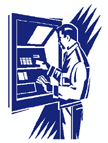|
|

|
|||||||||||||
 |
 
|
Looking After Your Money: Technology and BankingFact sheet #3 looks at some of the changes in day-to-day banking and issues that have emerged. It also provides some tips for using new methods of banking. Banking has changed dramatically in the last few decades due to technological advances. Many Canadians, including a growing proportion of older adults, now use telephone banking, internet banking or automated banking machines (ABMs) to carry out basic transactions. According to the Canadian Bankers Association, more than 60 percent of customers do most of their banking electronically. Fifty two percent of adults aged 55 and over have used a bank machine. There are more changes coming too, such as voice activated automated banking machines (ABMs) that are being tested in many locations. 
Automated Banking Machines (ABMs), also called automated teller machines (ATMs), are often located inside or near banks, in grocery, and other retail stores and in gas stations. To use an ABM, you must obtain a bank card and a personal identification number (PIN) from your bank. You can deposit or withdraw cash, transfer funds to another account, pay bills or receive a printout of your balance and recent transactions. The easiest and most common transaction carried out at ABMs is cash withdrawal. Even if you prefer to talk to a human teller, ABMs can: save time if there are line-ups at the tellers' wickets, provide 24-hour bank services seven days a week and eliminate the need to carry large amounts of cash, especially when travelling.
Internet Banking is conducted on a personal computer. Most transactions except deposits or withdrawals can be conducted. You need your bank card and a pre-registered password. It can be done at any time of day from the comfort of your home and is convenient, fast and relatively safe. If you have a touch-tone telephone, telephone banking can save a trip to the bank by allowing you to pay bills, transfer between accounts, and inquire about balances and recent transactions. You must pick a telephone password and tell your bank which bills you wish to pay with this method. It is safe and saves time and energy, especially in bad weather. Remember, if you change your telephone number you must inform the bank so it can update your telephone banking information. Safe Banking Tips
Challenges Encountered by Some PeopleDespite the growth in electronic banking, not all customers are able to, or want to, use the new methods. In addition, improvements in the design and functioning of the technology are still needed in many areas. However, as banks face global competition and other pressures on their services, smaller branches in rural areas are being closed, leaving their customers with little choice but to use an electronic method for some of their banking needs. For Canadians in rural areas who may have little or no access to the closest branch in another town, this trend can pose serious challenges. Using an ABM or internet banking may not be an option for other reasons, including those related to the natural processes of aging such as decreased vision or short-term memory loss, or perhaps a sense of mistrust towards technology and lack of access to training or a computer. Studies have shown that unless ABM technology is useful, convenient and safe, people tend to resist using it. Sources:2000 General Social Survey, Statistics Canada. Canadian Bankers Association. Fast Facts — Electronic Banking, Retrieved April 16, 2001 from http://www.cba.ca/eng/statistics/fastfacts/abms.htm Smither, Al-Awar and Braum. Technology and Older Adults: Factors Affecting the Adoption of Automatic Teller Machines. Journal of General Psychology, Provincetown, 1994. Techno Terms
[Previous] [Table of Contents] [Next] |
|